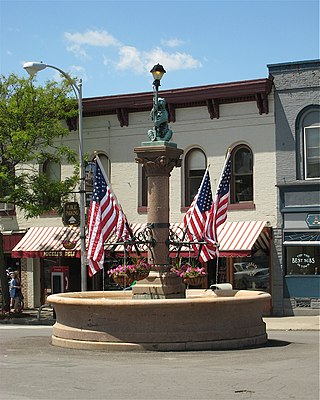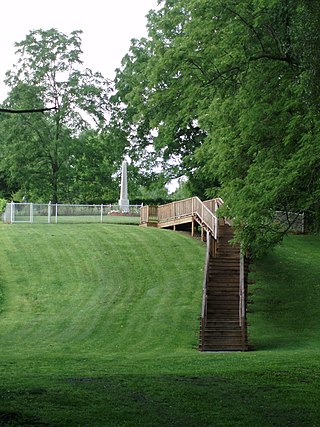Related Research Articles

Seneca County is located in the U.S. state of New York. As of the 2020 census, the population was 33,814. The primary county seat is Waterloo, moved there from the original county seat of Ovid in 1819. It became a two-shire county in 1822, which currently remains in effect and uses both locations as county seats although the majority of Seneca County administrative offices are located in Waterloo. Therefore, most political sources list only Waterloo as the county seat. The county's name comes from the Seneca Nation of the Haudenosaunee (Iroquois), who occupied part of the region. The county is part of the Finger Lakes region of the state.
Romulus is a town in Seneca County, New York, United States. The population was 3,203 at the 2020 census. The town is named after the mythical founder of Rome, Romulus, a name assigned by a clerk with an interest in the classics. It is located in the central part of the county, northwest of Ithaca, New York.

Horseheads is a town in Chemung County, New York, United States. The population was 19,412 at the 2020 census. The name of the town is derived from the number of bleached horses' skulls once found there.
Ovid is a village in Seneca County, New York, United States. The population was 602 at the 2010 census. The town was named by a clerk interested in the classics.

Waterloo is a village and primary county seat of Seneca County, New York, United States. The population was 5,171 at the 2010 census and is now the most populated village in Seneca County. The village is named after Waterloo, Belgium, where Napoleon was defeated. It is the primary county seat of Seneca County, with the other being Ovid as part of a two-shire system established in 1822. Most of the county administrative offices are located in the village. Therefore, many political sources only list Waterloo as the county seat.

The 1779 Sullivan Expedition was a United States military campaign during the American Revolutionary War, lasting from June to October 1779, against the four British-allied nations of the Iroquois. The campaign was ordered by George Washington in response to Iroquois and Loyalist attacks on the Wyoming Valley, German Flatts, and Cherry Valley. The campaign had the aim of "taking the war home to the enemy to break their morale." The Continental Army carried out a scorched-earth campaign in the territory of the Iroquois Confederacy in what is now western and central New York.
The Seneca are a group of Indigenous Iroquoian-speaking people who historically lived south of Lake Ontario, one of the five Great Lakes in North America. Their nation was the farthest to the west within the Six Nations or Iroquois League (Haudenosaunee) in New York before the American Revolution. For this reason, they are called “The Keepers of the Western Door.”

The Genesee River is a tributary of Lake Ontario flowing northward through the Twin Tiers of Pennsylvania and New York in the United States. The river contains several waterfalls in New York at Letchworth State Park and Rochester.

The Battle of Newtown was the only major battle of the Sullivan Expedition, an armed offensive led by Major General John Sullivan that was ordered by George Washington to end the threat of the Iroquois who had sided with the British in the American Revolutionary War. Opposing Sullivan's four brigades were 250 Loyalist soldiers from Butler's Rangers, commanded by Major John Butler, and 350 Iroquois and Munsee Delaware. Butler and Mohawk war leader Joseph Brant did not want to make a stand at Newtown, and instead proposed to harass the enemy on the march, but were overruled by Sayenqueraghta and other Indigenous war leaders.

The Phelps and Gorham Purchase was the sale, in 1788, of a portion of a large tract of land in western New York State owned by the Seneca nation of the Iroquois Confederacy to a syndicate of land developers led by Oliver Phelps and Nathaniel Gorham. The larger tract of land is generally known as the "Genesee tract" and roughly encompasses all that portion of New York State west of Seneca Lake, consisting of about 6,000,000 acres (24,000 km2).

The Cayuga are one of the five original constituents of the Haudenosaunee (Iroquois), a confederacy of Native Americans in New York. The Cayuga homeland lies in the Finger Lakes region along Cayuga Lake, between their league neighbors, the Onondaga to the east and the Seneca to the west. Today, Cayuga people belong to the Six Nations of the Grand River First Nation in Ontario, and the federally recognized Cayuga Nation of New York and the Seneca-Cayuga Tribe of Oklahoma.

John Abeel III known as Gaiänt'wakê or Kaiiontwa'kon in the Seneca language and thus generally known as Cornplanter, was a Dutch-Seneca chief warrior and diplomat of the Seneca people. As a war chief, Cornplanter fought in the American Revolutionary War on the side of the British. After the war Cornplanter led negotiations with the United States and was a signatory of the Treaty of Fort Stanwix (1784), the Treaty of Canandaigua (1794), and other treaties. He helped ensure Seneca neutrality during the Northwest Indian War.

Geneseo is a town in Livingston County in the Finger Lakes region of New York, United States. It is at the south end of the five-county Rochester Metropolitan Area. The population of the town was 10,483 at the 2010 census.

The Boyd and Parker ambush was a minor military engagement in what is now Groveland, New York on September 13, 1779, during the American Revolutionary War. A scouting patrol of the Sullivan Expedition was ambushed by Loyalist soldiers led by Major John Butler and their Seneca allies led by Cornplanter and Little Beard.
Conotocaurius was a nickname given to George Washington by Iroquois peoples in 1753. The name in its original language(s) has been given variously as Conotocarius, Conotocaurious, Caunotaucarius, Conotocarious, Hanodaganears, and Hanadahguyus. It has also been translated as "Town Taker", "Burner of Towns", "Devourer of Villages", or "he destroys the town".

Goiogouen, was a major village of the Cayuga nation of Iroquois Indians in west-central New York State. It was located on the eastern shore of Cayuga Lake on the north side of the Great Gully Brook, about 10 miles (16 km) south of the large 17th-century Cayuga town of Tiohero; and approximately along the southern line of the modern-day township of Springport, New York. It was located about four miles (6 km) north from Chonodote, the present-day location of the village of Aurora, New York and about two miles (3 km) south of the village of Union Springs, New York.
Canawaugus was a Seneca Indian village. The village was located on the west side of the Genesee River, "about a mile above the ford", on the eastern edge of the Town of Caledonia. It was nearly opposite of the Avon sulphur springs. The name means "stinking waters" because of the sulphur.

Kanadaseaga, was a major village, perhaps a capital, of the Seneca nation of the Iroquois Confederacy in west-central New York State, United States. It was located between the northern ends of Seneca and Canandaigua lakes, one and a half miles northwest of the present-day city of Geneva in the township of Seneca. The village was situated on both sides of Kanadaseaga Creek. The Seneca established this village at least as early as 1687. It was likely established by the former residents of Ganondagan, after its destruction by the French.
Little Beard's Town, also known as Chenussio and "Genesee Castle", was a powerful Seneca town in the Genesee River Valley near modern Leicester in Livingston County, New York, where Cuylerville stands today.
Fish Carrier or "Ojageght," which translates to English as "he is carrying a fish by the forehead strap," was an Iroquois chief of the Cayuga people. He supported the British during the American Revolution, participating in the Battle of Wyoming in 1778 and the Battle of Newtown in 1779.
References
- ↑ Jennings, Francis (1995). The History and Culture of Iroquois Diplomacy. Syracuse University Press. p. 218. ISBN 978-0815626503.
- ↑ Seneca County Historian. "Early History of Kendaia". Seneca Daily News. Retrieved May 24, 2015.
- ↑ "Indians of North America". Northeast Anthropology (65–68). 2003. Retrieved May 24, 2015.
- ↑ William W Betts JR (7 December 2010). The Hatchet and the Plow. ISBN 9781450267151.
- ↑ Gridley, Samuel H. (1879). The Centennial Celebration of General Sullivan's Campaign Against the Iroquois, in 1779, Held at Waterloo, September 3rd, 1879. Waterloo, New York: Waterloo Library and Historical Society. p. 132. Retrieved May 26, 2015.
- ↑ Stone, William Leete (1816). Border Wars of the American Revolution, Volume 2. New York: Harper & Brothers. p. 27. Retrieved May 25, 2015.
